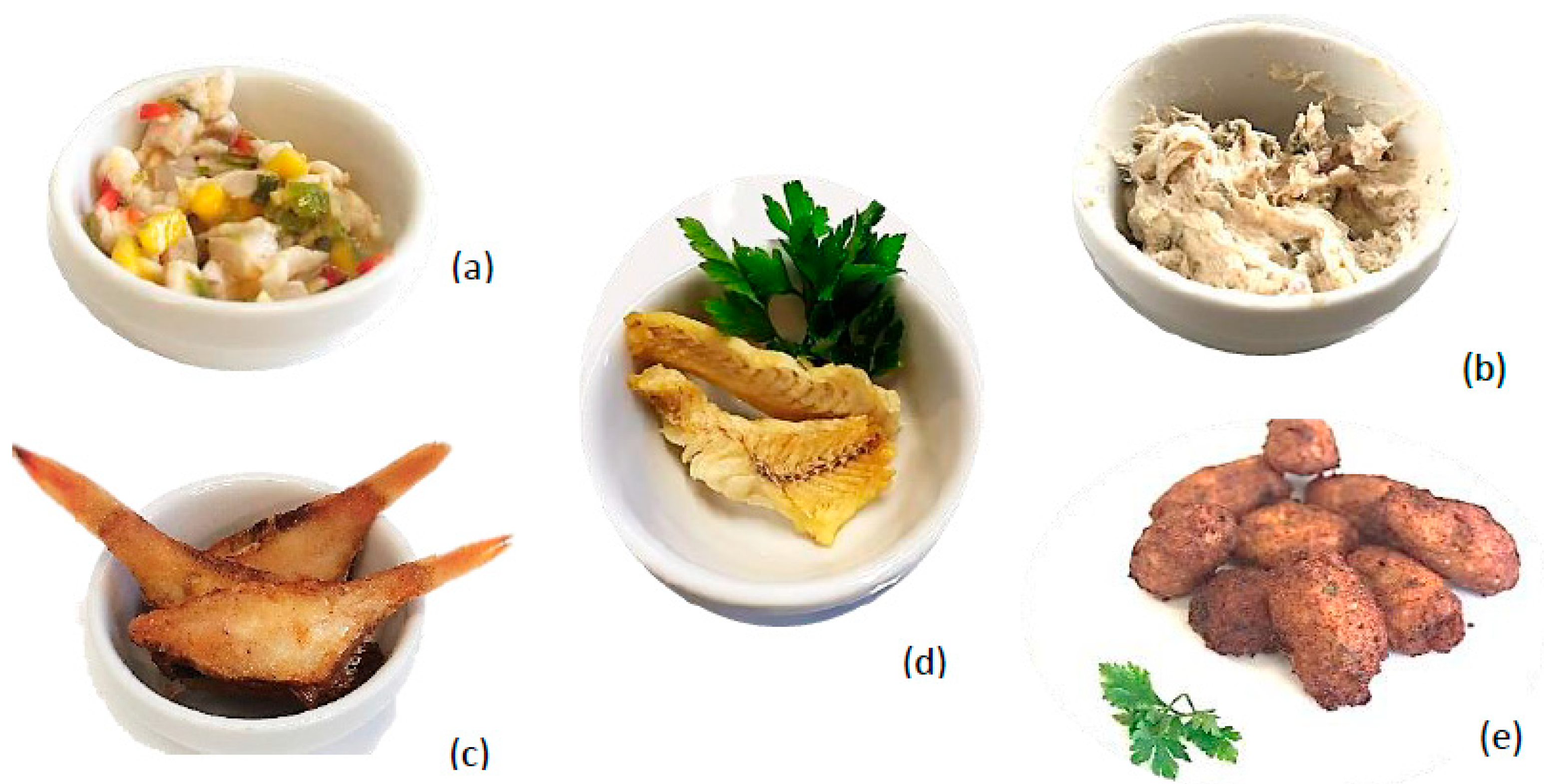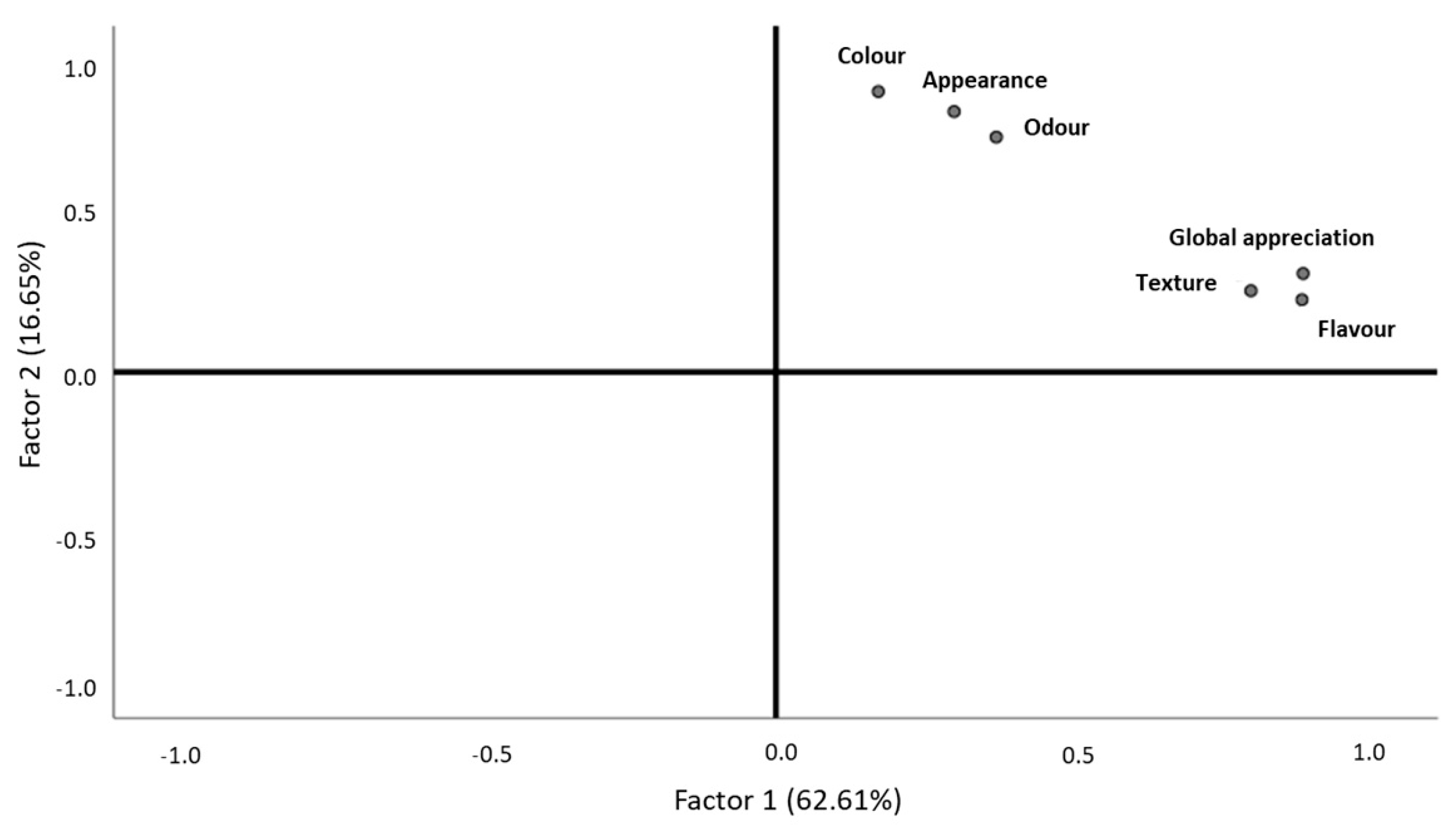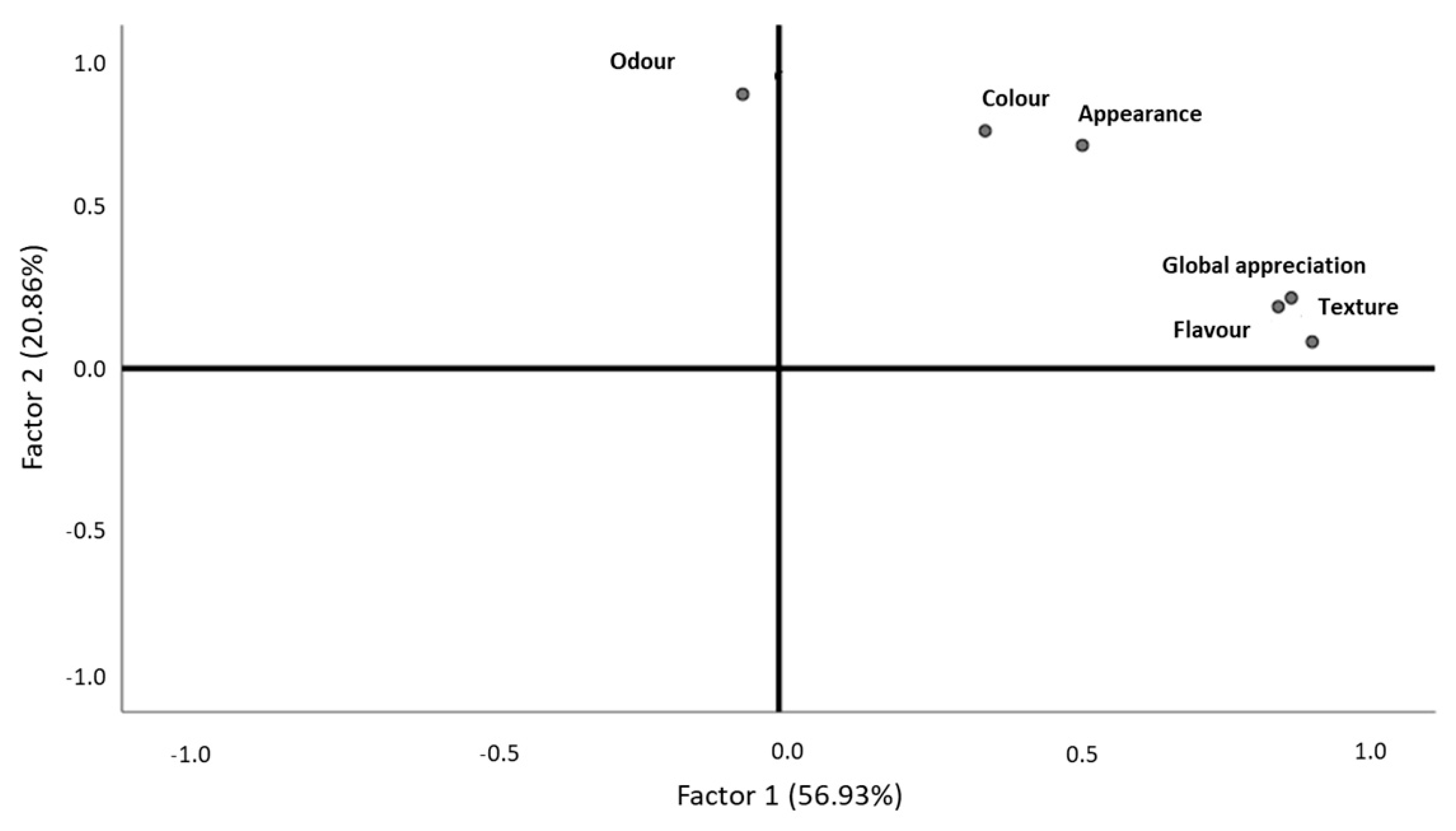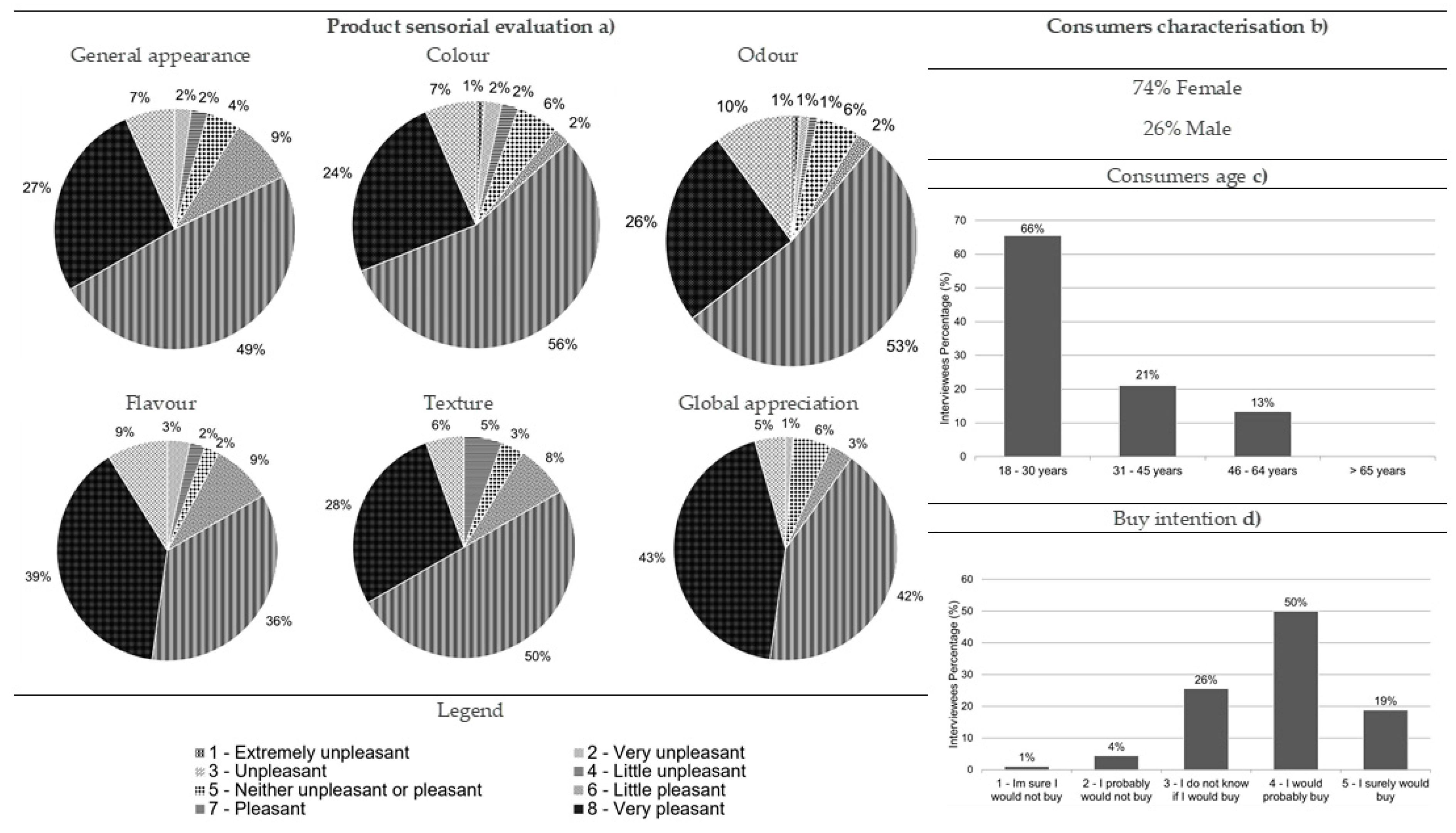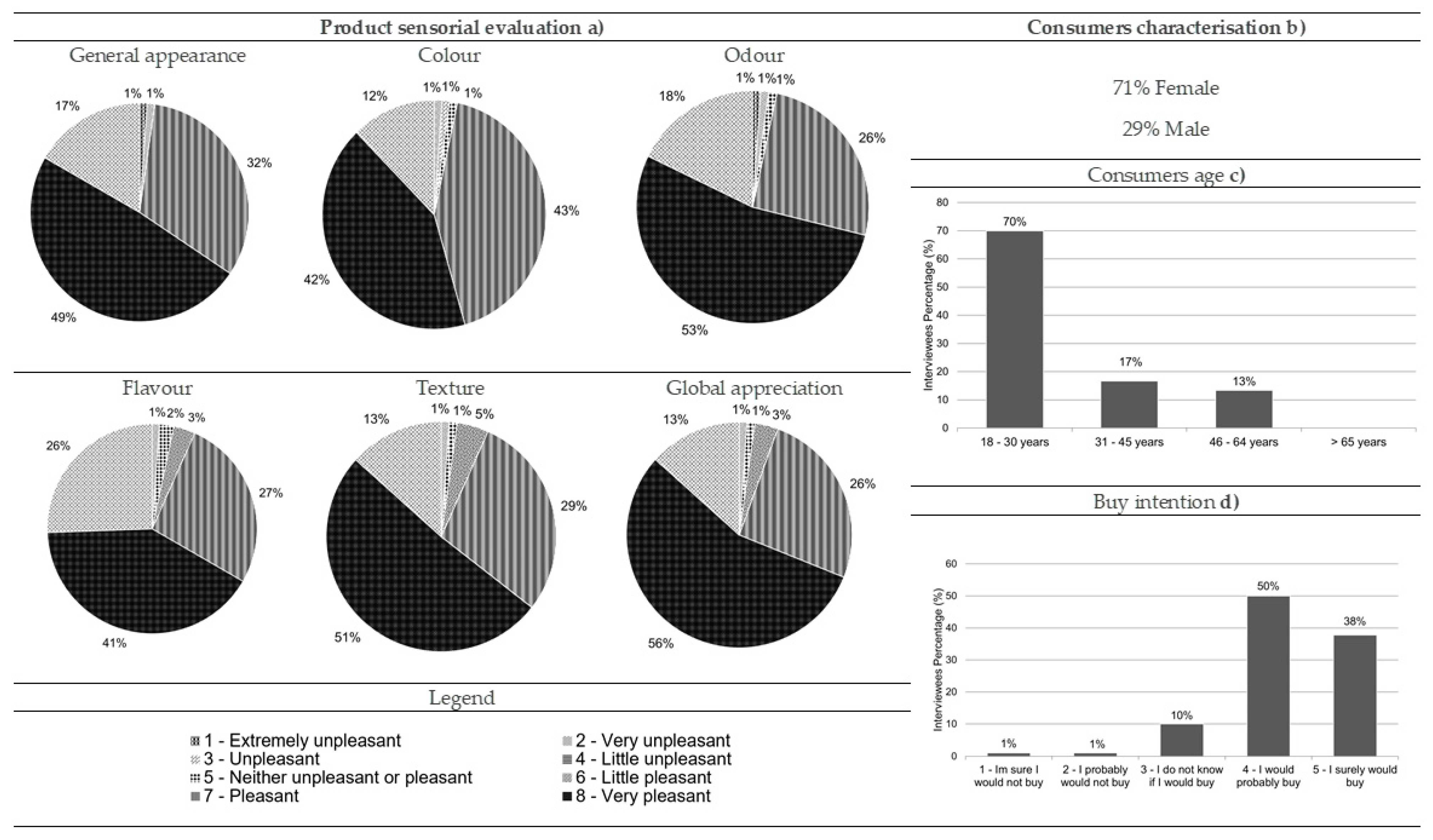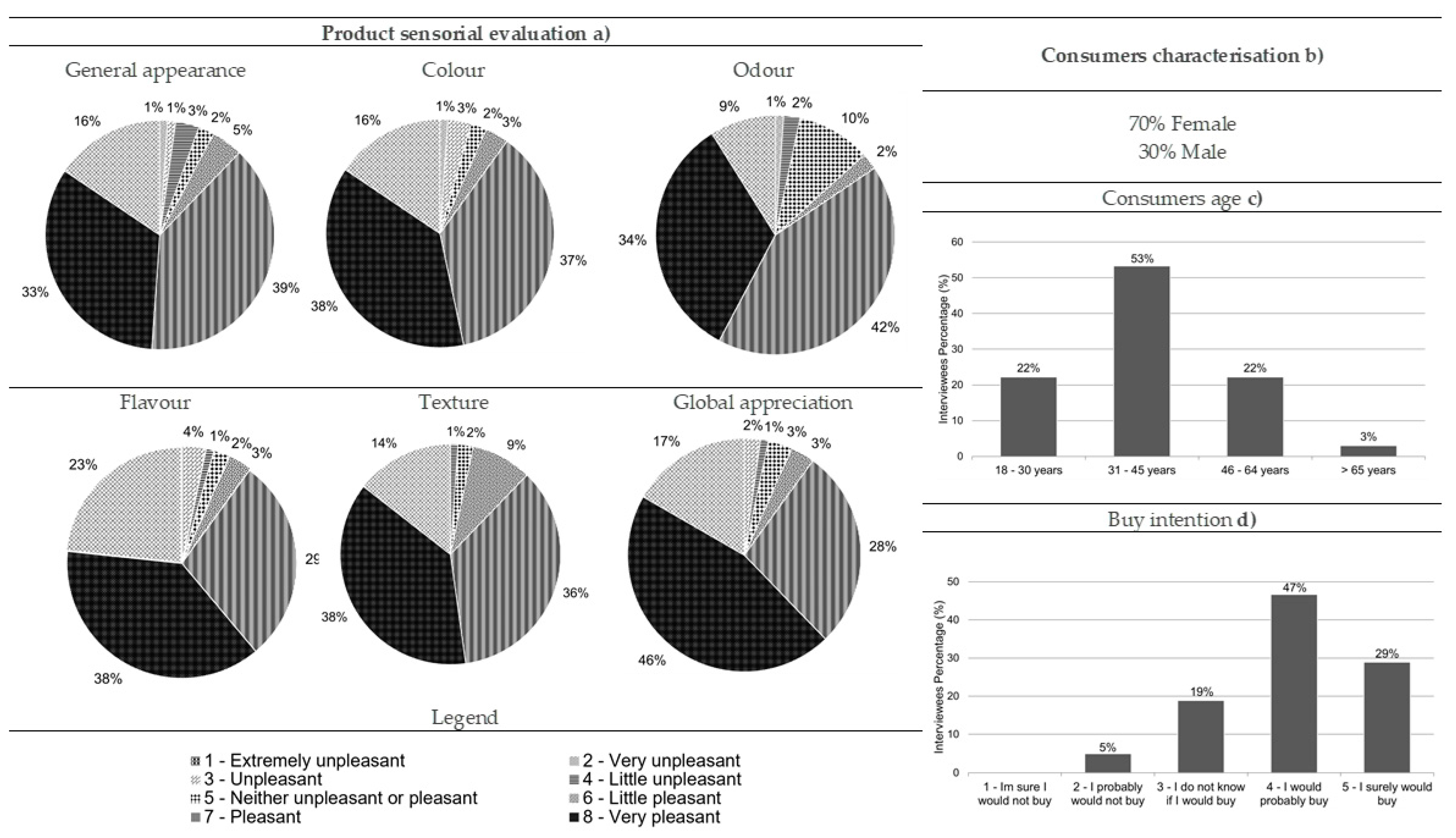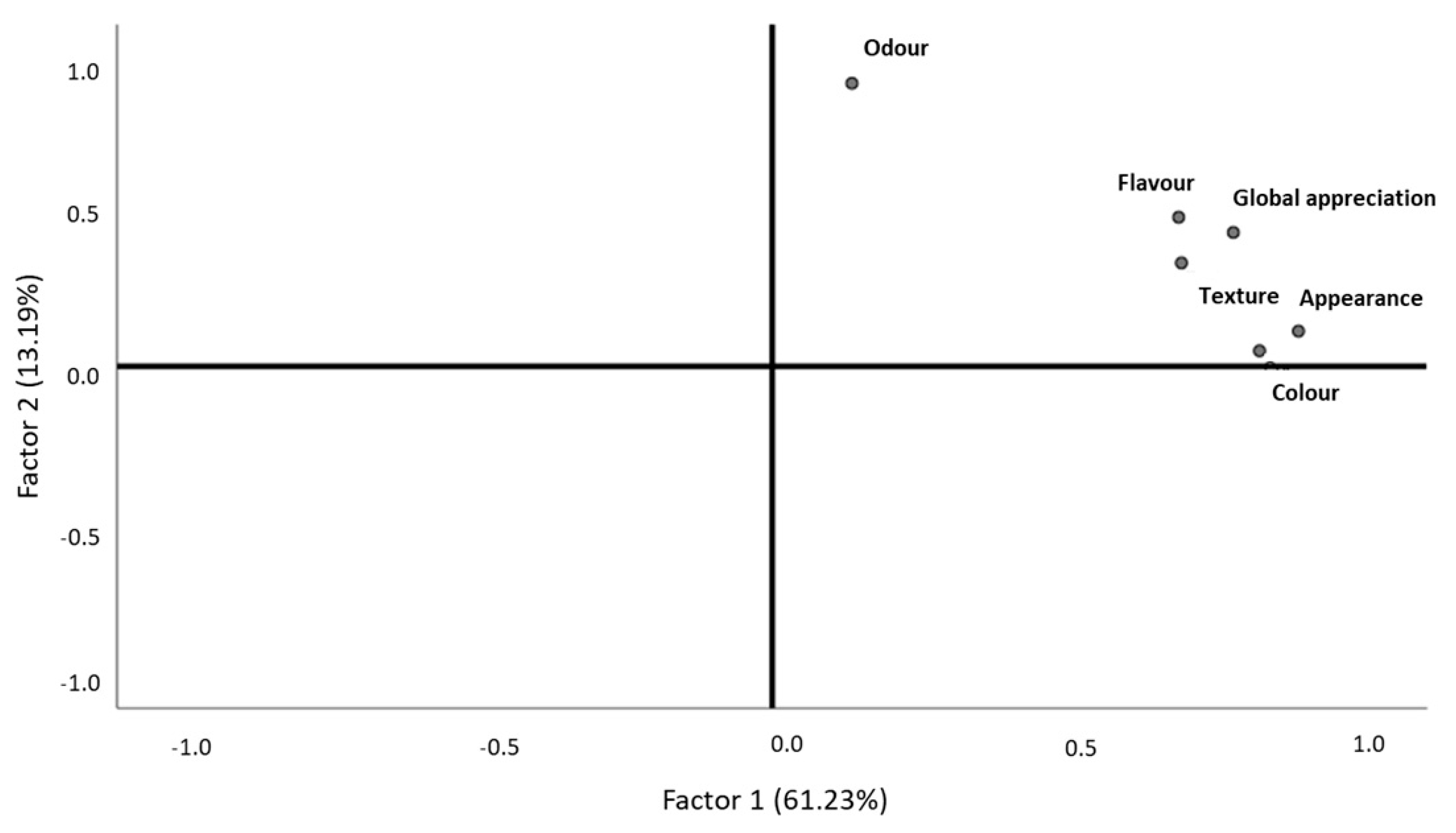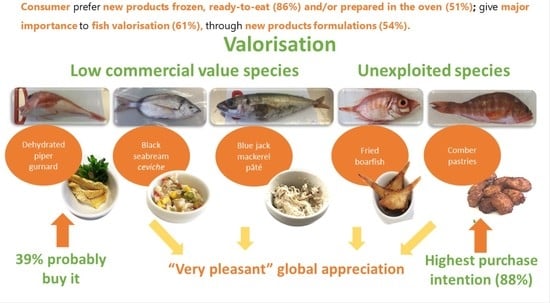1. Introduction
The growing world population and, consequently, the increasing need for food resources are demanding a more sustainable and circular bio-economy. In fact, the planet’s sustainability is one of the most discussed topics worldwide, with particular emphasis on marine resources. Despite the ocean’s richness in different fish species, consumers and industries only know a few of them, which are the ones with the highest commercial value. However, underexploited and underutilized fish species may offer added benefits for consumer health, given that their nutritional content as well as sensory attributes are equally pleasant as more commonly consumed fish [
1].
Fish species that are not targeted by fisheries are called bycatches, which means (a) species with low or no commercial value that are discarded to gain room on the vessel for commercial species caught later; (b) discarded species with no commercial value due to restrictive measures in terms of landing (quota, size below the minimum conservation reference size); (c) deteriorated species; or (d) protected species that cannot be caught, which in most cases do not survive [
2,
3]. Fish disposal results in marine ecosystem changes, which can be avoided with the exploitation of waste from bio-based industrial processes, including by-products, co-products, and discards (from fisheries), contributing to resource-efficient process improvement [
4].
In Portugal, the most consumed fish species are cod (
Gadus morhua), hake (
Merluccius merluccius) [
1], and canned tuna (made with some species from the Scombridae family) [
5,
6]. On the other hand, in Europe the top five consumed species, which accounted for 44% of the total volume in 2017, were tuna, cod, salmon, Alaska pollock, and shrimp [
7]. This consumption preference can be explained by the lack of consumer awareness of other species, which discourages their purchase. However, this may not be the only explanation, due to the complexity of food choice, which is influenced by many interrelated factors, including social, environmental, political, economic, and cultural aspects [
8]. According to Coralo et al. [
8] consumers’ attitude towards food can be categorized as (a) the Individualist: food choices based on their personal interests (e.g., economic convenience, personal mood); (b) the Foodie: food choices based on the sensory aspects related to food (e.g., better taste, right price–quality ratio); (c) the Environmentalist: food choices based on environmental sustainability issues (e.g., the integrity of the farmer, food origin); and (d) the Health Enthusiast: food choices based on contemporary diets (e.g., low-calorie diet) and analyzing label contents, claims, and health effects. Therefore, with consumer surveys, it is possible to quantify and measure consumption options and frequencies, which allows a pattern of eating behavior to be traced. Regardless of the population’s consumption habits, one of the ways to make a new fish species known is through its use in traditional products or in products that are familiar to the consumer, replacing the more commercial species. After acknowledging population consumption habits and expectations regarding new food products, this information is applied to product development and, subsequently, sensory tests are carried out to assess acceptability and purchase intention. Sensory evaluation allows for the establishment of a target market, the identification of the most important product features the avoidance of wasted effort during product development, quality issues to be dealt with; a comparison between brands, and an attempt at ensuring long shelf-life [
9]. Therefore, sensory evaluation is a result of human decision and, consequently, it is an outcome of complex interactions conditioned by personal history, environmental variables, subjective covariates, and object characteristics that also interact with the modality of the survey [
9]. In fact, sensory evaluation is essential for both new food product development and food reformulation of existing products.
Food reformulation is considered one of the contributors to achieving population nutrient goals (e.g., energy and salt reduction, clean labels) [
10,
11]. Therefore, food reformulation can be a way to valorize fish species with low or no commercial value by using them to replace the commercial ones. This both increases the value of underexploited and underutilized fish species and reduces the final price of the reformulated product, with the added advantage of avoiding overexploitation of species with significant commercial value.
When considering development of new fish-based food products, attention should be given to seasonality to achieve greater nutritional (e.g., fat and protein content) and sensorial (e.g., appearance, odor, flavor, and texture) features. Therefore, it is important to identify the best time of the year to capture fish considering the product formulation and, consequently, consumer acceptance, taking into consideration their life history, including their reproductive cycle and growth characteristics. Considering that there is a high probability of market failure when introducing new food products, it is crucial to know in advance the consumer habits and preferences to create or redesign and reformulate a product that satisfies their necessities [
12]. One of the approaches to gain this knowledge is to perform a market survey about consumers’ diet and the reason for their food choices (e.g., nutritionally rich, easy to prepare). Consumer characterization (e.g., gender, age, occupation) is also important to identify a potential target market segment.
Despite world fisheries and aquaculture production increasing in the last 30 years from 100 million tonnes in 1986 to 178 million tonnes in 2018 [
13], fisheries showed a stable value around 90 million tonnes between 1996 and 2016 and a slight increase to 96 million tonnes in 2018 [
13]. However, regardless of this stability in catches, the number of unsustainable (overfished) stocks has increased from 10% in 1974 to 34.2% in 2017. In addition, within the sustainable stocks, the number of underfished stocks decreased continuously from 1974 (around 38%) to 2017 (less than 8%), with the majority of stocks in the “maximally sustainably fished” category [
13]. In Portugal, as in other countries from temperate waters, most fisheries are multi-specific, meaning that besides the target species (usually species with high commercial value) other species are also caught. Among these, some are discarded at sea and others are landed but normally reach a low commercial value. In terms of stock status, many commercial species of more global (European) interest are studied and their stocks are assessed and managed by international organizations (International Council for the Exploration of the Sea—ICES). The other species, the great majority of them, namely those included in this paper, are not assessed and managed and the biological information is scarce and very often totally lacking. The minimization of discards and the valorization of non-commercial or low commercial species is therefore very important to present alternatives to the currently most exploited species. The inclusion of new alternative species in the market would allow the increase of first auction prices and then the interest of fishermen to shift their effort to these species, as occurred in the 1990s with the black scabbardfish fishery in Portuguese waters.
Therefore, the present study aims to value bycatch species with low commercial and non-commercial value. Among the former, three low commercial fish species were chosen: blue jack mackerel (
Trachurus picturatus), black seabream (
Spondyliosoma cantharus) and piper gurnard (
Trigla lyra). Why these species? These species are particularly relevant either because of their high landing values or their first auction prices. Among species of non-commercial value, the comber (
Serranus cabrilla) and the boarfish (
Capros aper) are particularly abundant in Portuguese waters, with
S. cabrilla being one of the most important species in terms of discards of several fisheries, namely gillnets and trawls, while
C. aper is among the 10 most important species in terms of abundance, being caught as bycatch in both crustacean and fish trawl fishing [
14,
15]. The valorization of these species is aimed at through the development of five innovative and differentiating marine-based products in relation to what currently exists on the market. A market survey about fish consumption habits, the applicability of fish product innovation, and the importance of valuing discarded fish was also performed.
2. Materials and Methods
2.1. Market Survey—Fish Consumption, Applicability of Fish Products Innovation, and Importance of Fish Valorisation with Low or Absent Commercial Value
A total of 155 consumers from Região de Lisboa e Vale do Tejo (Center of Portugal), answered to an anonymous market survey with 13 closed-ended questions divided into three groups: (1) consumer baseline characteristics, (2) fish consumption habits and their characterization, and (3) individual consumer preference and consumption patterns of processed fish products. In the first group, the consumer’s personal features (gender, age, level of education, and occupation) were identified. The second group was conceived to assess individual importance of fish consumption (rated on a scale of 5—Very important, 4—“Important”, 3—“Indifferent”, 2—“Less important,” and 1—“Not important”), the main attributes that are valorized in fish consumption (e.g., low fat content, protein, flavor), consumption frequency characterization (rated on a scale of 5—“Occasionally,” 4—“More than once a week,” 3—“Every week,” 2—“Twice a month,” and 1—“< once a month”), and to perceive the consumption of some fish species with low or no commercial value. The third group allowed for the appraisal of the willingness to consume new products derived from fish species with low or no commercial value, the main motivations for its consumption (e.g., low-price products, fast and practical products, nutritionally rich), how to consume them (e.g., to prepare in the oven, ready-to-eat products, or frozen products), an evaluation of the importance given to their valorization (rated on a scale of 5—“Very important,” 4—“Important,” 3—“Indifferent,” 2—“Less important,” and 1—“Not important”), and the importance of creating new fish products from them (rated on a scale of 5—“Very important,” 4—“Important,” 3—“Indifferent,” 2—“Less important,” and 1—“Not important”). This data collection, through a market survey, was done personally and ran from September to November 2019.
2.2. Fish-Based Food Product Production and Preparation
The fish species used in this work were blue jack mackerel, black seabream, piper gurnard, comber, and boarfish. The fish (captured on the Portuguese coast) were acquired at Peniche fish auction or purchased from local fishermen. The initial fish preparation included the removal of scales, internal organs, and head.
The fish products were developed by a Portuguese chef, considering the consumers’ answers to the survey, and the need to be sensorially pleasing and preferably ready-to-eat or with few preparation requirements. In addition, no food additives were added to any fish product. Given the consumers’ lack of knowledge about the fish species under study, it was decided to develop reformulations of products familiar to consumers. In addition, new consumption trends were also considered.
The black seabream used in ceviche formulation was initially filleted, the skin was removed, and then sliced into small cubes. The black seabream cubes were then mixed with the remaining ingredients, which included lime, lemon, chives, vinegar, ginger, mango, and red pepper.
For the preparation of the smoked blue jack mackerel pâté, the fish fillets were smoked with bay leaves, the skin was removed, they were minced, and then added to the remaining ingredients that included chili, cream cheese, pickles, onion, and mustard.
Piper gurnard skinless fillets were first deep-fried with vegetable oil and, after excess oil removal, the fish was dehydrated.
For the product formulation, the boarfish was first scaled, leaving the caudal fin, and then coated with flour and fried in vegetable oil.
For the preparation of the comber pastries, the fish was smoked with bay leaves, minced, and added to the other ingredients: mashed potato, onion, parsley, and egg. After mixing all the ingredients the pastries were molded with the help of spoons and deep-fried.
2.3. Hedonic Tests
Each of the fish products developed was evaluated by 90 consumers of both genders aged between 18 and 75 years old with a hedonic sensorial test at the “European night of researchers” event in Lisbon, Portugal. The aim was to measure the overall hedonic perception of a product by consumers. This test had 9 closed-response questions and was divided into three groups: (1) consumer characterization (gender and age), (2) product sensorial evaluation (general appearance, color, odor, flavor, texture, and global appreciation), and (3) purchase intention. The sensorial evaluation was performed considering a scale of 9 (“Extremely pleasant”), 8 (“Very pleasant”), 7 (“Pleasant”), 6 (“Not very pleasant”), 5 (“Neither pleasant nor unpleasant”), 4 (“Not very unpleasant”), 3 (“Unpleasant”), 2 (“Very unpleasant”), and 1 (“Extremely unpleasant”), and the purchase intention from 5 (“I’m sure I would buy”), 4 (“I would probably buy”), 3 (“I don’t know if I would buy”), 2 (“I probably wouldn’t buy”) and 1 (“I’m sure I wouldn’t buy”).
2.4. Statistical Analysis
Descriptive statistics and exploratory data analysis were performed on 155 consumers sampled in the same region to characterize the fish consumer profile, the applicability of fish product innovation, and the importance of valorizing discarded fish. An exploratory factorial analysis (EFA) was performed to achieve a parsimonious representation of the associations among measured descriptors (that is, appearance, color, odor, flavor, texture, and global appreciation). Prior to running the EFA, the uniformity of the sample was tested by the Kaiser–Meyer–Olkin (KMO) measure of sampling adequacy. A KMO value of more than 0.50 was considered acceptable. In addition, the measure of sampling adequacy of the anti-image correlation matrix was all greater than 0.5. The presence of correlations between measured descriptors was tested using the Bartlett test of sphericity and was accepted when it was significant at
p-value < 0.05. The correlation matrix was also analyzed and values of more than 0.3 were considered suitable [
16]. As regards the sample size, there are several guiding rules cited in the literature [
16,
17,
18] and the lack of agreement is noted in all of them. In this work, it was an option to follow the recommendation denoted as a ratio of N:
p, where N refers to the number of participants and
p to the number of variables. Thus, the ratio of respondents to variables should be at least 10:1 [
19], which was satisfied by the data set under study. Principal component analysis (PCA) was used for factor extraction and orthogonal rotation (varimax option) to minimize the number of indicators that have high loading on one factor [
20]. The number of factors was retained based on the eigenvalue >1.0 criterion (Kaiser criterion) and a plot of the eigenvalues, which shows the total variance associated with each other [
21]. For all analyses, this resulted in the extraction of the first two factors.
Spearman’s rank–order correlation coefficient was used to assess the co-variation of the descriptor scores. The Kruskal–Wallis non-parametric test was performed to assess the statistical differences between descriptor scores and purchase intention when comparing age groups. When significant differences were achieved, the Games–Howell or Bonferroni multiple comparison tests were executed. The use of the Kruskal–Wallis test proved to be appropriate, since it allows for the comparison of distributions of two or more ordinal variables less observed in two or more independent samples. Finally, the Mann–Whitney non-parametric test was performed to assess the statistical differences between descriptors and purchase intention when comparing consumer gender.
All analyses were performed for the five fish-based products that were developed. The significance level was set to p-value < 0.05. Analyses were carried out using IBM SPSS Statistics 26 software.
4. Conclusions
The present study allowed us to achieve great findings on interviewees’ habits of fish consumption, as well as their marine sustainability conscience, namely on underexploited and underutilized fish valorization and the main attributes for their consumption. According to the initial survey data, it was also possible to understand the receptivity to new fish products, preferably frozen, ready to eat, or to be prepared in the oven, which need to be properly promoted. The knowledge on consumers’ interests acquired with the data from the initial survey allowed for the development of new fish products, with the addition or substitution of the fish species under study through the reformulation of existing products that are familiar to the consumer. These products have a clean label, great acceptability, and purchase intention by the consumers. The results from hedonic tests revealed their potential application by companies to increase their revenue due to low or absent commercial value of discarded fish species. In fact, consumer evaluation revealed that they probably would buy all the developed products, with their global appreciation classified mainly as “very pleasant,” except for the dehydrated piper gurnard, which was classified as “pleasant.” In addition, the consumers favored the texture and flavor of the black seabream ceviche and dehydrated piper gurnard, with the addition of color for the comber pastries. The flavor and color of the fried boarfish were the most important features for consumers, with the addition of texture and appearance in the smoked blue jack mackerel pâté. Therefore, considering all our data and the need to avoid fish overexploitation, the species in this study revealed to be a great alternative to commercialized species commonly used in fish products. However, more research is needed to study Portuguese fish consumption, as well as their opinion about the inclusion of unexploited fish in their diet.
As future perspectives, it is intended to study and extend the shelf-life of the developed products through appropriate and sustainable packaging and maintaining the clean label.
